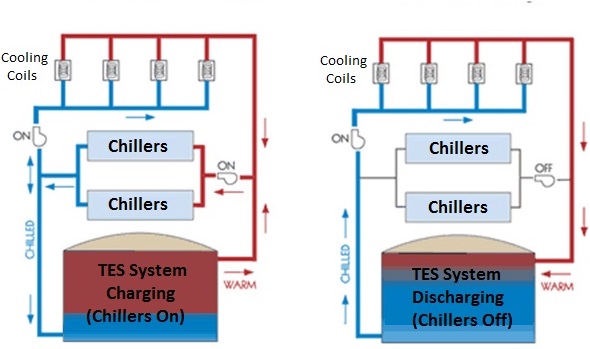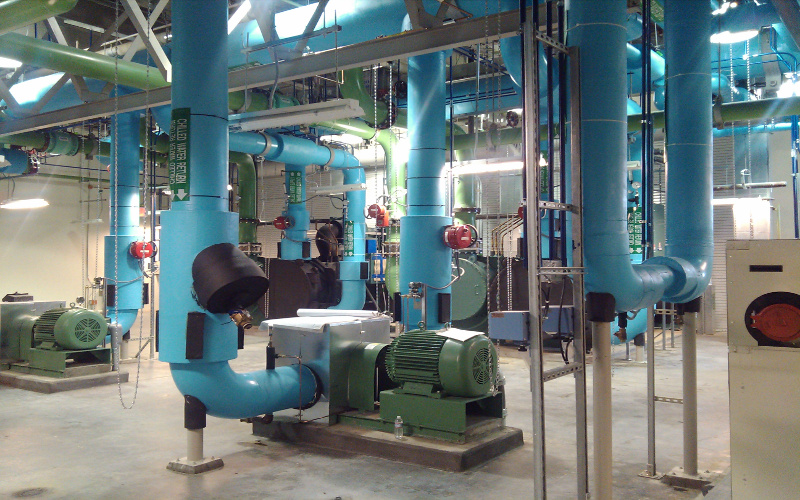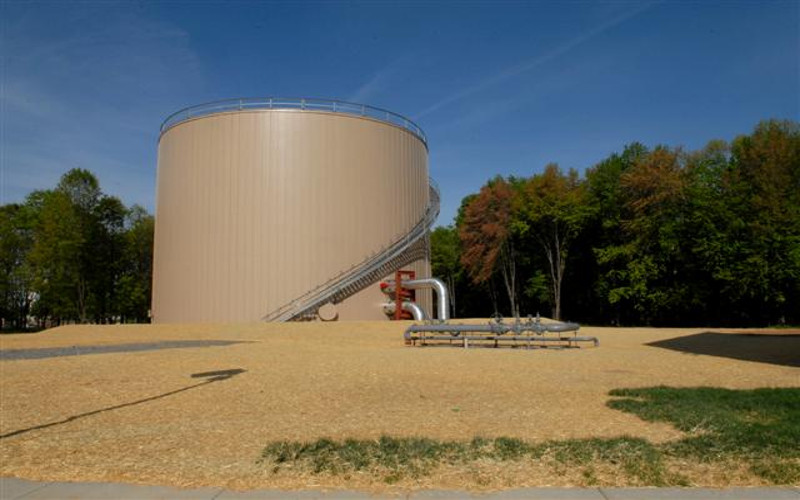Reliable Chilled Water Using Thermal Storage
Thermal Energy Storage Process Flow Diagram

Cooling loads often represent the largest electrical load for utilities to serve.
This is particularly true for mission critical facilities that contain a high density of electrical load per square foot like that found in biosafety labs, data centers, or communications facilities. Highly reliable chilled water is essential for these facilities.
Cooling demand tends to occur when overall grid demand for electricity is already high, such as during hot and humid days when bottlenecked points on aging transmission and distribution (T&D) grids approach near-failure operating points.
It is during these times of peak energy demand when distribution system voltages drop from increased loads.
These T&D strains propagate to distribution feeders and can ultimately impact end-use cooling equipment that is being called upon to provide peak performance.
During periods of hot weather and high loads, chilled water systems respond to grid-wide voltage drops by drawing an increasing amount of electric current. This response further strains connected load feeders, sub-transmission grids, and accentuates voltage upsets. Thermal energy storage systems (TES) used to serve or to offset air conditioning-related (A/C) demand provide an especially significant benefit related to reduced need for generation and T&D capacity. This is critically important for areas or regions experiencing electrical supply shortages or T&D congestion. Similarly, storage can also be used to offset the need for some ancillary services, especially voltage support, and it can also serve to improve local electric service reliability and power quality.
Thermal Energy Storage Provides Reliable Chilled Water and Improves Electrical Power Quality
Critical Facilities = High Energy Densities
Critical facilities and high cooling loads typically go hand-in-hand. Energy densities found in semiconductor facilities, pharmaceutical manufacturers, data centers, government labs, intelligence agencies, and even some greenhouses, drive high cooling loads and demands. Even momentary power losses that disrupt cooling for only a few minutes can disrupt sensitive processes, tests, batches, and wafer runs that can cost millions in scrap and rework.
Thermal energy storage systems reduce exposure to momentary outages and can be designed to support peak loads or shave demand for varying hours depending on need. Outages driven by power loss, mechanical failure, or planned maintenance can all be safely mitigated with energy storage systems.
Thermal Energy Storage Benefits
Enormous Turn-Down Capability
Chiller Load Shifting
High Round-Trip Efficiency
Variable Interval Discharging (long vs. short)
Emergency Cooling for Mission Critical Loads
Contractually Guaranteed Efficiency
High Chiller Efficiencies
Offsetting Energy Reliability Costs with Demand Savings
Thermal energy storage systems take advantage of lower off-peak rates to make chilled water or ice at night. The system stores cooling energy onsite and discharges it, or melts it, throughout the facility for cooling during the day when rates are highest. With most storage systems, only one-third or so of cooling requirements are typically supplanted by off peak-generated chilled water. That simple shift can reduce a cooling bill by 40-50 percent. This significant level of savings is due to the delta between off-peak and on-peak energy pricing. The Edison Electric Institute (EEI) reports that the only form of energy that has not increased in price over the past 40 years, when converted to today’s dollars, is off-peak electricity.
A common misconception is that if your facility is not offered “time-of-use” utility pricing, you are on a tariff that will not potentially benefit from thermal energy storage. This is not necessarily the case since demand charges are a component of most utility bills. Typically, when demand charges are converted to daytime energy usage, electricity costs are about half the cost during nighttime hours, even when you are not offered a time-of-use rate. A demand charge is a portion of the commercial energy bill that reflects peak energy usage measured in 15-minute intervals across the billing cycle. Amounts vary, but the demand charge can be steep – typically 20-80 percent of your monthly energy cost.
Some tariffs have clauses that are known as “demand ratchets,” meaning that a year-high demand peak set during a single 15-minute billing interval can trigger demand charges for the following 11-month billing period, based solely on that single 15-minute interval period. Ratchet tariffs incorporate minimum billing demands based upon historical peak demands. For example, if the peak demand last summer was 500 kW and the rate design has a 50% ratchet, the minimum billing demand would be 250 kW (500 kW times 50%) for the following 11 months, regardless of whether the actual demands for most of the year were lower. One hot summer afternoon can lock facilities into a high demand charge for the next 11 months.
By moving a portion of your cooling requirements to off-peak periods, demand peaks during peak usage periods are reduced or eliminated. Given the high-reliability nature of thermal energy storage systems, they can be trusted to effectively shave high summer demand peaks, enabling users to avoid setting short-duration demand peaks that can trigger costly annual demand ratchets.
Get Paid to Use Less Energy
During summer months, the grid strains under high demand for A/C. Utility- and Regional Transmission Organization-sponsored (RTO) Demand Response (DR) programs pay end-users to reduce peak electrical consumption. The freed-up and unused capacity is then sold back to the grid through the RTO or Independent System Operator (ISO). Simply put, stored cooling becomes a Virtual Power Plant, (VPP) so building occupants stay cool and comfortable while lowering peak energy use at the building location and on the grid.
Demand Response encourages less energy use during peak times, lowers end-use energy bills and provides revenue that can fund resiliency projects or simply be added to bottom-line profits or budgets.





